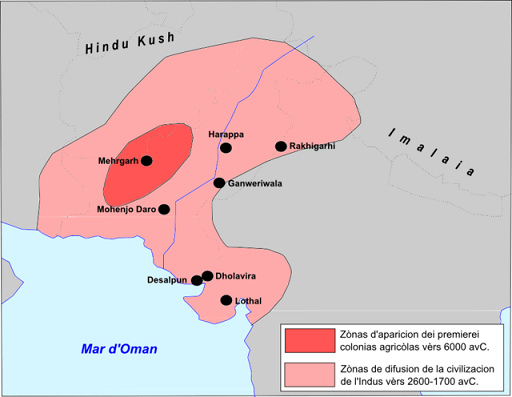The Harappan Civilisation was not a combination of recently immigrated Central Asians, Iranians or Mesopotamians which imported civilizational knowledge, but instead was a distinct group which 유전자 diverged long before the advent of HC. Furthermore, due to the suggested 유전 distinctness of the HC, it seems unlikely that language in that geographical region was imported by an Indo-European group as is often theorised. Lastly, the study demonstrates that the DNA of HC inhabitants had little contribution from Central and West Asians but did have a contribution to modern South Asian genetics.
이전에 인더스 계곡 문명으로 알려진 하라판 문명(HC)은 최초의 문명 중 하나입니다. 문명 to independently arise. HC became “mature” at around 2600BCE; having meticulously planned towns with complex drainage systems, and wide scale standardisation of weights and measures. The civilisation was by far the biggest in its era, with HC including most of northwest South Asia. The 유전 analysis conducted of an ancient woman called “Rakhigarhi woman” (named after the modern town in India in which her remains were found), estimated to have lived between 2300 and 2800BCE in an HC town, sheds light on the ancestors and possible descendants of the individuals who lived in HC.
이 고대 여성의 미토콘드리아 DNA도 시퀀싱되었습니다. 미토콘드리아 하플로그룹 (this indicates a common ancestor on a genetic lineage) was U2b2, which is not a haplogroup found in ancient mitochondrial genomes of Central Asians suggesting that this women was native to the HC region and was not 유전자 a migrant from Central Asia. Furthermore, this haplogroup is found almost exclusively in modern South Asia suggesting that modern South Asians may descend either from the individuals who were part of HC or may share similar ancestral lineage to them.
The Rakhigarhi woman’s DNA was also significantly different from 고대 DNA found in Turkmenistan (Bronze Age Gonur) and Iran (Shahr-i-Sokhta) from around the same time period, but surprisingly it has differences with DNA of modern South Asians suggesting that modern South Asians may have descended from similar lineages that the HC descended from or that the 유전학 of South Asians may have evolved since the HC.
The ancient woman’s DNA is uniquely diverged. HC ancestry is believed to have 13% DNA which is diverged from common ancestry with the South-East Asian hunter-gatherers (Andamanese) and farmers (Dai) perhaps 15 to 20 thousand years ago; the rest 87% is diverged from common ancestry with Iranian hunter-gatherers, herders and farmers perhaps 10 to 15 thousand years ago. This suggests that the HC was not a combination of recently immigrated Central Asians, Iranians or Mesopotamians which imported civilizational knowledge, but instead was a distinct group which 유전자 diverged long before the advent of HC. Furthermore, due to the suggested 유전 distinctness of the HC, it seems unlikely that language in that geographical region was imported by an Indo-European group as is often theorised. Lastly, the study demonstrates that the DNA of HC inhabitants had little contribution from Central and West Asians but did have a contribution to modern South Asian 유전학.
***
출처:
V. 신데, V. 나라심한, 외 2019. 고대 Harappan 게놈에는 대초원 목축가 또는이란 농부의 조상이 없습니다. 셀. 179권, 3호, P729-735.E10, 17년 2019월 05일. 게시: 2019년 XNUMX월 XNUMX일. DOI: https://doi.org/10.1016/j.cell.2019.08.048
***






































